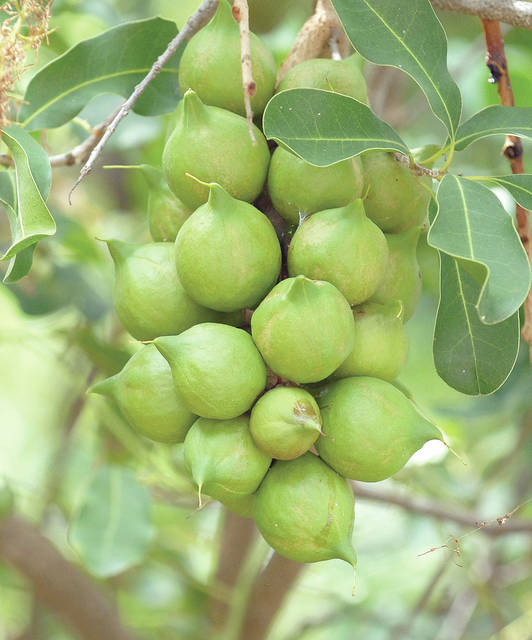KAILUA-KONA — Macadamia nuts number among Hawaii’s most important and lucrative agricultural exports, and 2017-18 was a banner year.
The state’s utilized macadamia nut production jumped 17 percent year-over-year to 49 million pounds, the highest mark in six years, according to the National Agricultural Statistics Service (NASS).
Hawaii also posted a record farm price, the amount growers are receiving from processors, as farmers grossed $0.914 per pound and netted $1.10 per pound, the latter up 10 cents from 2016-17. NASS also estimated overall farm value of Hawaii’s macadamia nut crop at $53.9 million, up 28 percent from last year.
Hawaii Island supports a substantial majority of macadamia nuts grown across the state.
Glenn Sako, agricultural specialist with the Hawaii County Department of Research and Development, explained a fixed acreage of roughly 16,000 harvested acres per season coupled with a bump in global demand for macadamia nuts accounts for much of the increased profitability.
“I would say China is a big consumer, as the middle class is starting to use their income to purchase some more of these gourmet products,” Sako said.
However, the impacts of escalating trade disputes between the United States and China could dent Hawaii’s profits heading into next season, as roasted macadamia nuts and “other unhulled macadamia nuts” are on China’s list of U.S. exported goods facing tariffs.
Both categories of macadamia nut are staring down the barrel of 15 percent tariffs.
Considering the fixed acreage, state supply of macadamia nuts is also relatively dynamic and largely reliant on weather patterns. Sako said moisture is typically the greatest factor in overall production, particularly on the southern edge of Hawaii Island.
Last season, Pahala and other areas surrounding South Point saw an uptick in rainfall. Troy Keolanui, farm manager at OK Farms, which is associated with the Ed Olson Trust, said the dry and arid climate on Hawaii Island’s south end is the most conducive to a strong crop yield.
The increased rain improved yield this year, but only to a point. OK Farms, which farms 600 acres worth of macadamia nuts in both South and East Hawaii, suffered a roughly a 25 percent production decline associated with its east side operations last year because rainfall was too intense.
And next season may prove even worse, Keolanui said. He described projections for OK Farms, as well as projections for other operations, as “very bleak” in East Hawaii. Too much rain between December-March, traditional flowering months for macadamia nuts, is the culprit.
As a result, Keolanui believes OK Farms might suffer through a 40 percent production decline next year, which is likely to lead to layoffs.
“It’s entirely situational,” he said. “The best laid plans can fall to pieces in agriculture.”
The impact of fewer available jobs in the industry may not hurt Hawaii’s agricultural economy as much as it would seem, as traditional hurdles dogged Hawaii macadamia nut farmers again this year — particularly in the forms of labor shortage and pest infiltration.
The nut harvest, like those of other popular crops in Hawaii, requires hand pickers, Keolanui explained.
“Most of the coffee picking, and we do a considerable amount of coffee cultivation, is (done by) Hispanic people happy to come and get the work,” he said. “It is hard to find local people that will do it.”
Keolanui said OK Farms hasn’t suffered due to stricter immigration enforcement under the Trump administration because the operation has always made it a point to hire documented workers.
Smaller operations that need hire only a handful of pickers, however, may struggle to find employees as undocumented workers have to be more careful crossing state and national borders.
And replacing those hands won’t be easy.
“To get American youngsters out there to try and do this,” Keolanui said, “most won’t last a week.”
Sako said some outfits have implemented recruiting bonuses, boosted fringe benefits and added free transportation to their offerings to try and attract and keep workers. But the immigrant workforce, he explained, just isn’t what it used to be.
The macadamia nut industry is also short on state-subsidized programs to help control pests like the macadamia felted coccid (MFC) the way the coffee industry can rely on programs that offer cost mitigation for crop treatments to combat the invasive coffee berry borer.
“Sen. (Mike) Gabbard was able to secure some funding a couple of years ago for MFC,” Keolanui said. “But the problem is that money goes to research and studying (the problem). It isn’t hands-on money for the farmers so that they can get the sprays and the equipment they need to treat the pests.”
Hawaii harvests roughly 16,000 acres of macadamia nut trees annually, but problems surrounding labor shortages and pests leave around 2,000 acres unharvested every season.

